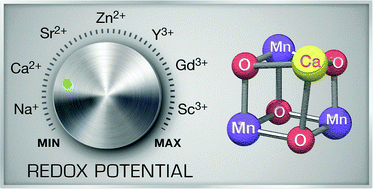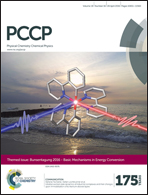Redox potential tuning by redox-inactive cations in nature's water oxidizing catalyst and synthetic analogues†
Abstract
The redox potential of synthetic oligonuclear transition metal complexes has been shown to correlate with the Lewis acidity of a redox-inactive cation connected to the redox-active transition metals of the cluster via oxo or hydroxo bridges. Such heterometallic clusters are important cofactors in many metalloenzymes, where it is speculated that the redox-inactive constituent ion of the cluster serves to optimize its redox potential for electron transfer or catalysis. A principal example is the oxygen-evolving complex in photosystem II of natural photosynthesis, a Mn4CaO5 cofactor that oxidizes water into dioxygen, protons and electrons. Calcium is critical for catalytic function, but its precise role is not yet established. In analogy to synthetic complexes it has been suggested that Ca2+ fine-tunes the redox potential of the manganese cluster. Here we evaluate this hypothesis by computing the relative redox potentials of substituted derivatives of the oxygen-evolving complex with the cations Sr2+, Gd3+, Cd2+, Zn2+, Mg2+, Sc3+, Na+ and Y3+ for two sequential transitions of its catalytic cycle. The theoretical approach is validated with a series of experimentally well-characterized Mn3AO4 cubane complexes that are structural mimics of the enzymatic cluster. Our results reproduce perfectly the experimentally observed correlation between the redox potential and the Lewis acidities of redox-inactive cations for the synthetic complexes. However, it is conclusively demonstrated that this correlation does not hold for the oxygen evolving complex. In the enzyme the redox potential of the cluster only responds to the charge of the redox-inactive cations and remains otherwise insensitive to their precise identity, precluding redox-tuning of the metal cluster as a primary role for Ca2+ in biological water oxidation.

- This article is part of the themed collection: Bunsentagung 2016: Basic Mechanisms in Energy Conversion

 Please wait while we load your content...
Please wait while we load your content...